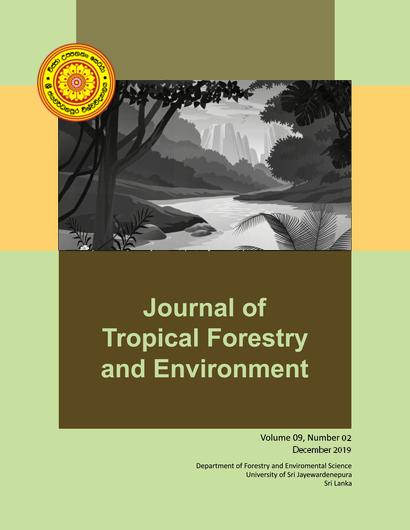Identifying the Strength Grade for Finger Jointed Timber Species According to BS 5268-2:2002
DOI:
https://doi.org/10.31357/jtfe.v9i2.4468Abstract
Off-cut wood is currently considered as waste thus is dumped by saw mills as they find no means of utilising them. Sawn timber material of furniture factories and short length of sawn timbers are also considered to be wastes in the timber industry. Finger jointing technique which interlock the end joints formed by machining a number of similar tapered symmetrical fingers are recognised in this regards as effective and sustainable means of utilisation of timber wastes. The present study was undertaken to assess the strength grade of finger jointed timber based on BS 5268-2:2002. Seven timber species which are commonly used in Sri Lanka were employed for the assessment with and without finger joints. Values of Modulus of Rupture (MOR), Modulus of Elasticity (MOE), Compression parallel to grain and Compression perpendicular to grain strength of the specimens were measured. Finger jointing was performed with constant geometry (finger length 19 mm, tip width 1 mm and finger pitch 4 mm) using polyvinyl acetate (PVA, P-SWR) adhesive at normal exposure conditions. The strength properties were evaluated by Universal Testing Machine (UTM) according to BS 373:1957. Strength classes relevant to the grade stresses were not significant for finger jointed and clear specimens of Satin, Mahogany, Jack and Grandis. Both clear and finger jointed timber specimens obtained D40 for Satin and Teak, D30 for Jack, Mahogany and Grandis. Teak shows properties similar to both D35 and D40 when used as finger jointed timber. Kumbuk was shown to change from D40 to D30 while using as finger jointed timber. Finger jointed Pine showed stress grade of C22, C24 and C27.Downloads
Published
2019-12-11
How to Cite
Muthumala, C., Silva, S. D., Arunakumara, K., & Alwis, P. (2019). Identifying the Strength Grade for Finger Jointed Timber Species According to BS 5268-2:2002. Journal of Tropical Forestry and Environment, 9(2). https://doi.org/10.31357/jtfe.v9i2.4468
Issue
Section
Articles
License
The publisher retain the copyrights of contents published, and all open access articles are distributed under the terms of the Creative Commons Attribution-Noncommercial-No Derivative Works 3.0 Unported License[U1], which permits unrestricted use, distribution and reproduction in any medium, provided that the original work is properly cited.
You can download the Legal Code for this License at: http://creativecommons.org/licenses/by-nc-nd/3.0/legalcode


